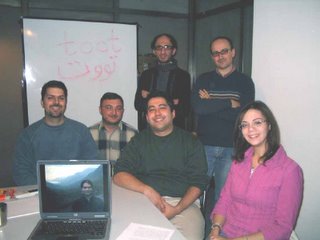
When the Palestinian singer and music researcher Reem Kelani, on a visit from London, told women in the Palestinian refugee camp of Ein el-Hilweh in southern Lebanon her name they immediately burst into the traditional song “Sprinting Gazelle”. This was a tribute to the name Reem, which means gazelle (or more specifically, according to the Hans Wehr Arabic dictionary, white antelope or addax).
The spontaneous performance of the song by women of three generations epitomises the irrepressibility and deep-rootedness of Palestinian musical culture. The women also demonstrated for Kelani the circle dance that accompanies the song at weddings
Kelani has over the years done vital work in recording, arranging and singing the songs she has collected, as well as composing her own songs. The song she heard in Ein el-Hilweh is now the title track of her debut CD “Sprinting Gazelle: Palestinian Songs from the Motherland and Diaspora”, newly released on the British label Fuse Records. The infectiously danceable title track includes musician Tigran Aleksyan on the double-reeded yarghul that is played at Palestinian weddings.
The CD opens with Kelani’s haunting rendition of “As Nazarene Women Crossed the Meadow”, unaccompanied but for a background vocal drone. According to local Nazarene folklore, women would sing this song while saying goodbye to menfolk leaving to serve in the Ottoman Army.
In the CD’s sleeve notes, Kelani recalls how an elderly man from Shefa Amer near Nazareth approached her after a performance she gave in Dubai “and said that he had not heard this song for at least 60 years.”
Some of the ten tracks are based on traditional songs, such as “The Cameleer Tormented my Heart”, “Galilean Lullaby” and “A Baker’s Dozen”. Other tracks feature Kelani’s compositions for Palestinian poetry: “Mawwal – Variations on Loss” based on poetry by Mahmoud Darwish, “Yearning” by Rashid Husain, “Yafa!” by Mahmoud Asim al-Hout and “Qasidah of Return” by Dr Salma Khadra Jayyusi. The CD concludes with the rousing “Il-Hamdillah – Giving Praise”.
Running through the tracks is a sense of longing and pain, mingled with joyfulness and vibrancy. Kelani’s remarkable voice enters deep into the soul of the music with emotions ranging from tenderness to passion and fury.
Kelani is supported by a terrific lineup of musicians. Her core band, with which she often appears in performance, includes jazz pianist Zoe Rahman, whose piano improvisations (taqasim) add a magical dimension to tracks such as the evocative “Yafa!”
Woodwind whiz Idris Rahman plays clarinet, bass clarinet and tenor saxophone. On the percussion side, Iranian Fariborz Kiani plays daf, tombak and naghghareh, and Parick Illingworth plays drums. Oli Hayhurst is on double bass and Samy Bishai plays violin.
The sleeve notes are in the form of a 16-page booklet rich in information on each track and with the lyrics in both English and Arabic. The literary consultant is Palestinian scholar Dr Salma Khadra Jayussi and the poetry consultant the well-known British poet Alan Brownjohn. The cover and sleeve notes were designed by Nada Irani, and the Persian-style calligraphy was done by Iranian calligrapher and musician Bahman Panahi.
Reem Kelani is at:
http://www.reemkelani.com/
Susannah Tarbush
Saudi Gazette 31 January 2006







